When working with databases, it’s no longer a question of whether you should make a backup or not. After all, just a tiny error on the human side or a malfunction of software could ruin an enormous amount of data irreversibly. Things shouldn’t be any different with Salesforce and often the absurd amount of information stored in their ecosystem. Therefore, running a proper Salesforce backup has no doubt become a must!
What Salesforce data backup methods you can consider
The selection of methods depends very much on what it is that you wish to back up from Salesforce. Here, it’s important to distinguish between two types of data that are commonly exported out of Salesforce: data and metadata.
Data are any records you can find in Salesforce: contacts, deals, accounts, and others. This category also encompasses custom object records, uploaded files, as well as data generated within Salesforce Chatter.
Metadata, on the other hand, is the derivatives such as configuration, reports, dashboards, layouts, as well as any custom code.
There are many different ways of backing up your data as well as metadata and hundreds of different tools for doing so. What’s more, you can create a backup with several different native approaches too.
We’ll explore different use cases and hopefully help you decide on the right one for you.
What are the native Salesforce backup solutions?
Salesforce used to have a service called Data Recovery Service. Through it, the Salesforce team would help you recover any data stored on the platform (no metadata, though). Caveat – the feature came with a hefty price tag of $10,000 per use and would take 6 to 8 weeks to fulfill a task. Even then, the team couldn’t guarantee that all lost data would be recovered.
Data Recovery Service was discontinued in July 2020, then shortly restored the following year only to be officially retired later in 2021. As the demand for such service was significant, Salesforce released a brand new service towards the end of the year called Salesforce Backup and Restore.
Salesforce Backup and Restore – the native Salesforce backup tool
Salesforce Backup and Restore is a native tool for creating backup copies of a Salesforce database, including all the data stored in the platform. As the name suggests, it can also restore select sets of data if the need arises to do so.
Among its features, there’s an audit of existing and upcoming backups, controls of who can access, handle, and restore backups as well as advanced criteria for restoring data. The Salesforce team also confirmed that users will be able to perform analytics on the backed-up data both in the tool’s interface as well as in the usual place for analytics in Salesforce.
The data backed up through this service is stored in a separate data center, albeit in the same geographical location. As such, a regional outage could, temporarily, make it difficult to access both the production data and the backed-up copies. Given Salesforce’s track record of maintaining a very high uptime, this shouldn’t cause much of an issue in the long run.
Salesforce Backup and Restore is a paid add-on with no fixed price tag. If you’re up for trying it, you’re encouraged to get in touch with your sales rep to discuss the details.
Salesforce backup data export
If Backup and Restore doesn’t work for you, try the most straightforward approach – simply exporting the data using the built-in functionality.
In the Lightning version of the UI, you’ll find it by clicking on Data -> Data Export in the leftmost menu.
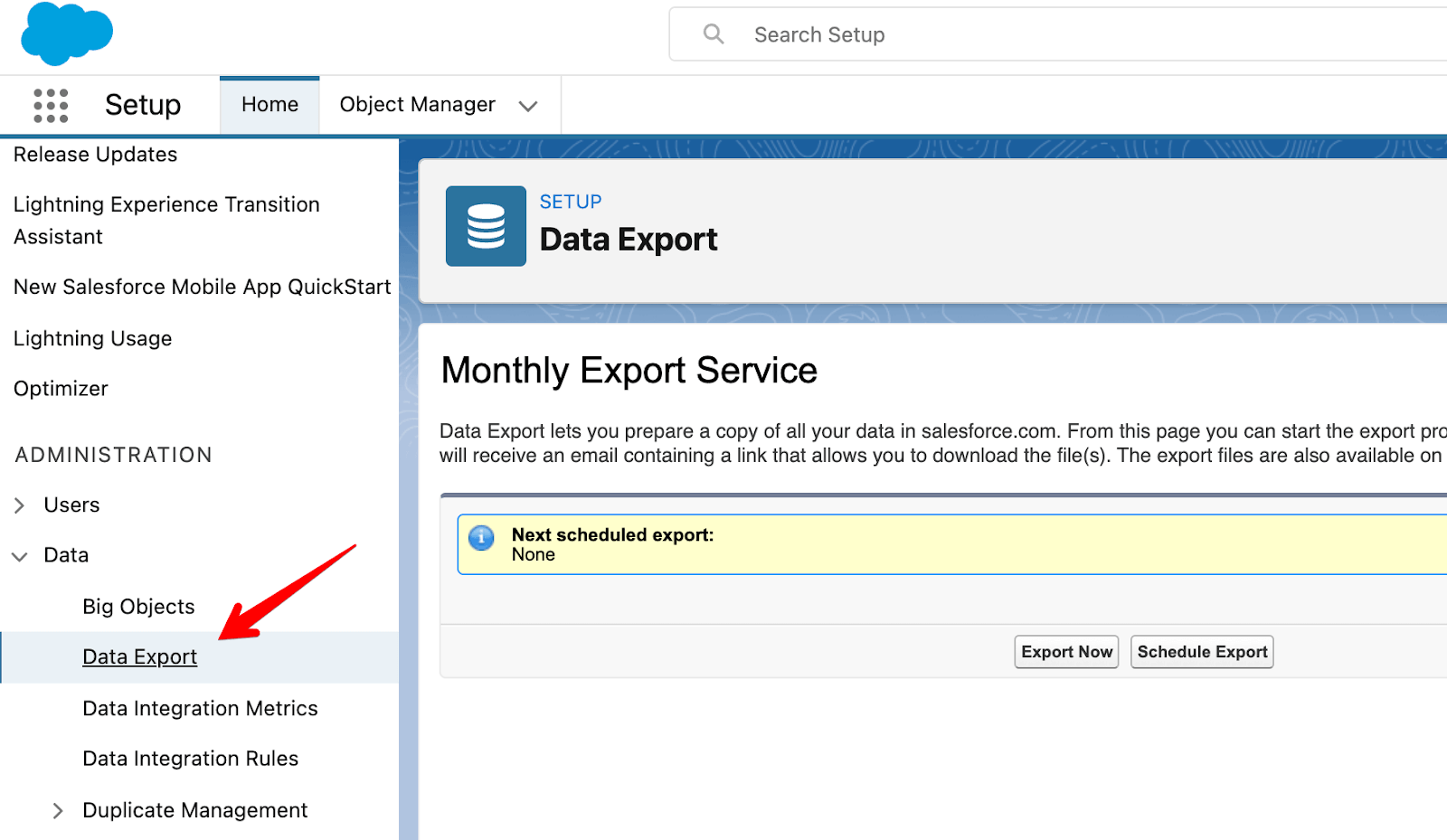
In the classic look of Salesforce, you’ll also want to click Setup in the top-right corner of the screen and then Data Management -> Data Export.
Whichever way you follow, there are two options available. You can:
- Export all or select data manually. You can choose precisely what type of data you need (e.g. contacts, opportunities). You may also include images, documents, attachments, and others if you’d like.
- Schedule data export. With this feature, you can automate the data export and receive the chosen types of data by email, e.g. on the 1st Monday of a month. Same as above, you can also choose to export all of your data (but not metadata).
For any method you choose, you can export data from Salesforce once a month or once a week if you’re on Enterprise, Performance, or Unlimited plan.
Check out another article where we explained how to export data from Salesforce in more depth.
How to create a Salesforce backup with Data Loader
Another viable way of exporting data from Salesforce is with Data Loader.
Ironically, we refer to it later as a potential threat because it’s capable of updating or importing large data sets at once, potentially causing a major setback. Simultaneously, it’s also invaluable at exporting mass sets of data to form a Salesforce backup.
Data Loader is available as a downloadable client. Through it, you can manually export specific data entities or all your Salesforce data at once. Note that attachments won’t be included in such exports.
Compared to the built-in export feature, there’s no limitation as to the frequency of data exports. However, contrary to the alternative method, you can’t schedule exports, you would need to perform them manually.
There are some tricks for pulling that off with the use of the command line but we can’t vouch for their effectiveness. Instead, we’ll show you viable, no-code, or low-code alternatives in the following chapters.
What is an automatic Salesforce backup?
A popular Salesforce backup solution is third-party apps, hundreds of which were created to facilitate the process. There are over 100+ applications in the Salesforce Appexchange capable of backing up your data. Many more are also available outside of Salesforce’s ecosystem.
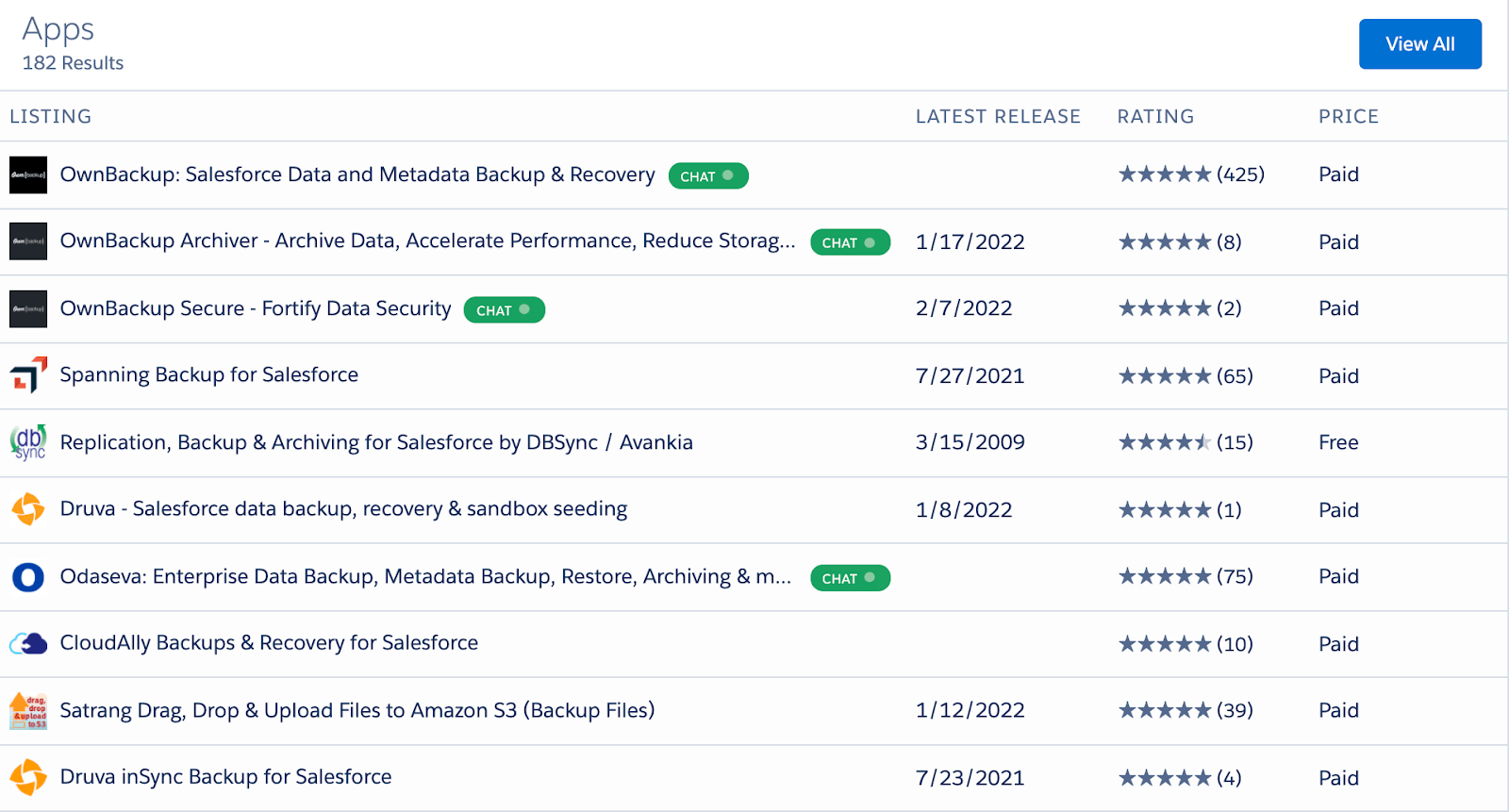
Although each does pretty much the same thing, feature-wise they can heavily vary. Some are capable of pulling both data and metadata, while others will focus solely on specific data types. Some apps can perform both a backup and restoration of the Salesforce database.
What’s more, certain apps not only back up the data but can also store it in a database or a spreadsheet app of your choice, maintaining the highest level of Salesforce data security. This way, you can kill two birds with one stone and have both a secure copy of your data and excellent material for analysis.
One such solution is Coupler.io – a reporting automation platform to turn raw data into smart reports. It lets you export data from Salesforce and 60+ other apps, such as Hubspot, Jira, or QuickBooks. With it, you can connect Salesforce data to spreadsheets, data warehouses, and BI tools.
How to back up Salesforce using Coupler.io?
Coupler.io lets you export three types of data from Salesforce:
| Data type | Description |
|---|---|
| Reports | You can extract data from the following tabular reports: Accounts report Orchestration Run Logs Orchestration Runs Orchestration Stage Runs Orchestration Step Runs Orchestration Work Items All private (custom) tabular reports |
| Objects | Select from over 100 standard or custom objects such as account, contact, lead, opportunity, etc. |
| Custom SOQL | Make a custom request in SOQL language. |
To get started, select a destination app in the form below and click Proceed. You’ll be prompted to create a Coupler.io account for free.
1. Collect Salesforce data
Connect and authorize your Salesforce account. Next, choose the data type you want to export from Salesforce.
- For reports, specify the report you need
- For objects, select the object you need
- For Custom SOQL, enter an SOQL query
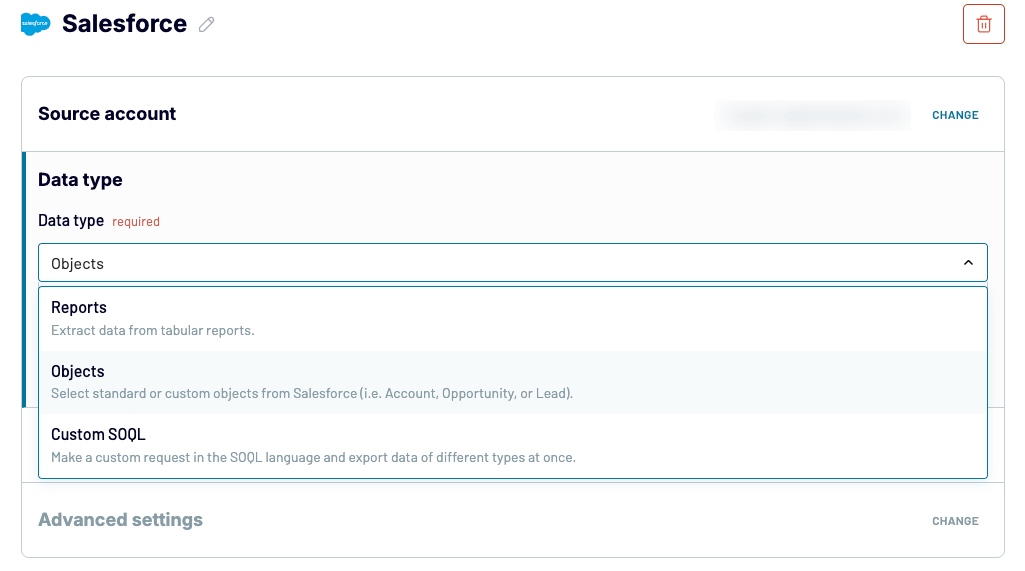
If you want to fetch multiple types of data, it will be as simple as duplicating your data flow and amending a few details later on.
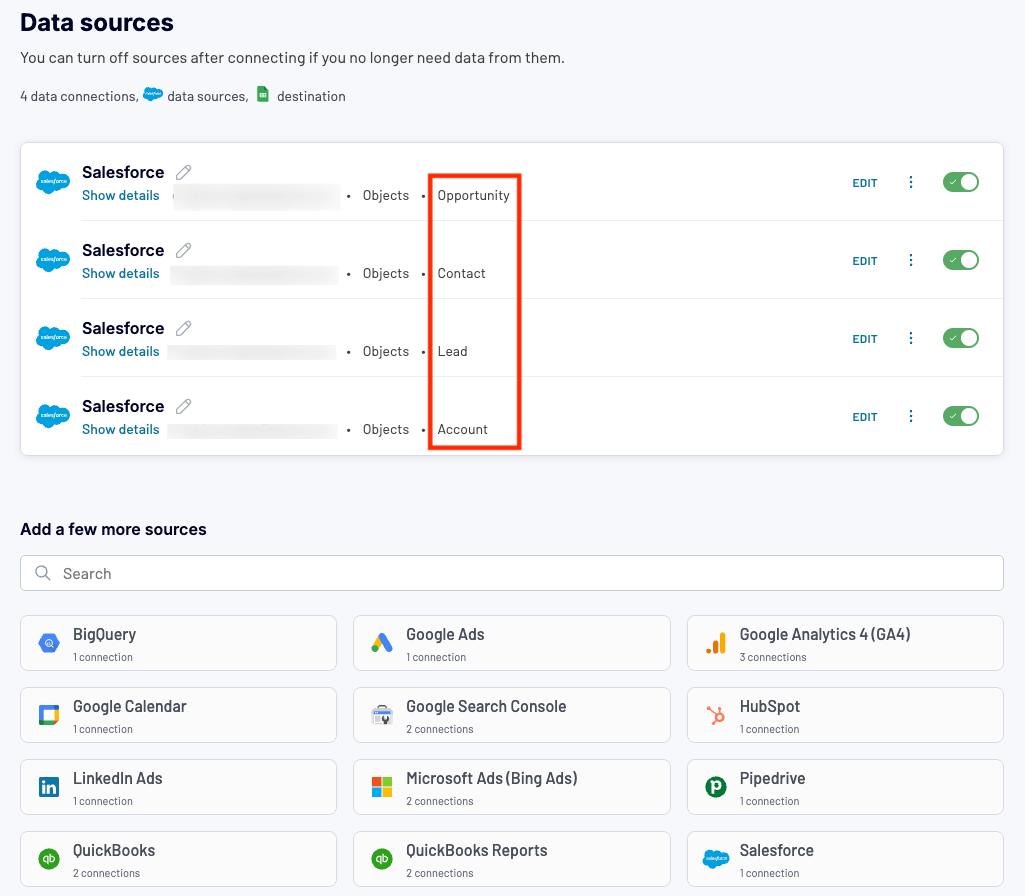
2. Transform and organize your data
In the next step, you can preview and transform your Salesforce data before loading it to the destination:
- Filter and sort data
- Hide, rename, edit, reorder columns
- Add custom columns using formulas
- Aggregate data to reveal key insights and trends
- Blend data from multiple data entities, Salesforce accounts, or even other apps.
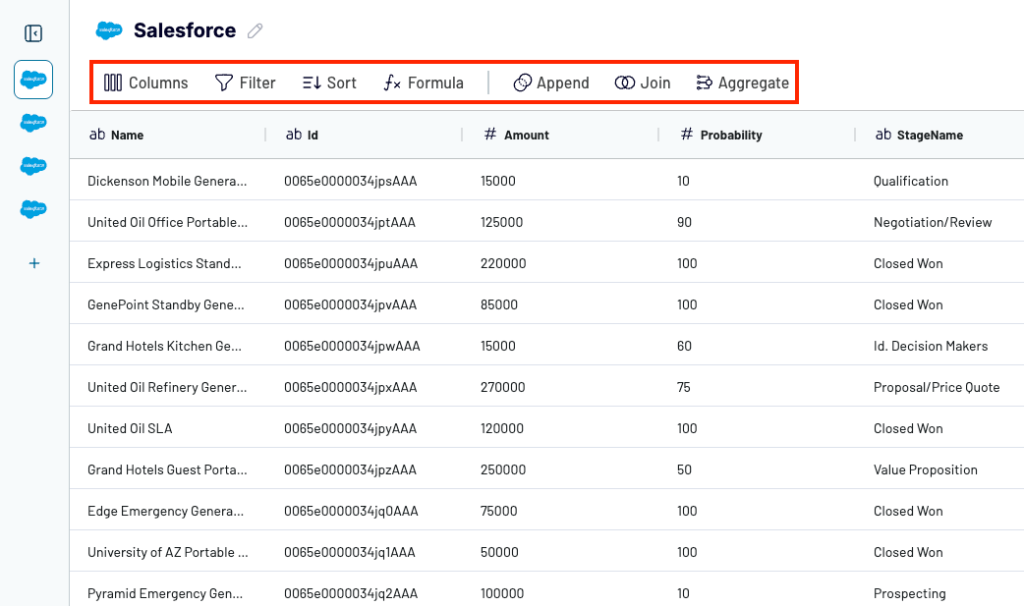
Using the above listed features of Coupler.io, you can not only clean up but also organize your data to have a refined and easy-manageable backup.
Once your data is organized, set up a destination connection.
3. Schedule data refresh
As the last step, toggle Automatic data refresh on and configure the schedule for your data flow. You can decide on the frequency, as well as days of the week, time, and time zone for the data refresh.
How to create a Salesforce daily backup
With Coupler.io, you only need to enable the Automatic data refresh and set the schedule interval to Daily. You can also decide whether your data flow should run every day, or perhaps you would like it to pull data on weekdays.
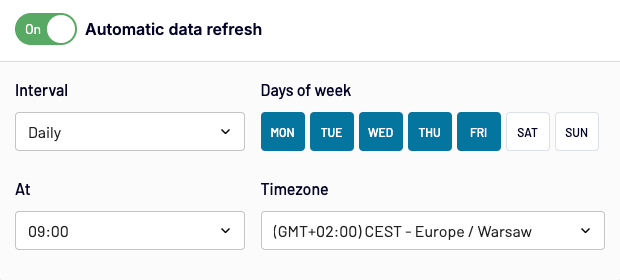
How to create a Salesforce weekly backup
If you want to schedule a Salesforce weekly backup with Coupler.io, you need to try a different approach. There’s no Week option in the Interval menu. You can, however, incorporate a workaround.
Keep the Interval as Daily. Deselect all weekdays but one and choose a suitable time. For example, we want to have our weekly backup to be pulled every Monday at 7 am so we’ll go with something like this:
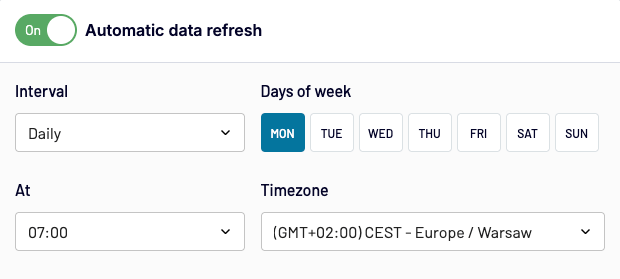
Why use external Salesforce backup tools?
The native backup option isn’t bad by any means – many businesses rely on it as the only backup solution, and they likely haven’t been disappointed. There are, however, several reasons why third-party backups may be preferable:
- Performance
Whichever tool you choose, running backups or exporting data must be their core business. As such, you can be confident they’ll do their best to ensure the constant uptime and the high performance of their service. If they can’t provide it regularly, they’ll likely go out of business sooner than later.
This is not to say that Salesforce backups are not reliable. It’s just one of the hundreds of features of Salesforce, and you probably can’t expect the same speed and devotion to solving problems as you would with a dedicated service.
- Compliance
Third-party apps may help you comply with your own policies. If data from all apps you use is backed up hourly, so should the Salesforce data. Although Salesforce seems to be offering some frequency settings in its Salesforce Backup and Restore feature, third-party apps can certainly be customized further.
The same goes for the destination of your data. If privacy laws or internal regulations require you to store Salesforce backups in a particular location – e.g., on the EU-based server or on-premises – the native method may prove insufficient.
- Easier backup overseeing
Many solutions allow backing up data from multiple apps on top of Salesforce. This can effectively save you plenty of time and make the setup easier.
It’s also far easier to manage all backups from a single console or a few of them at most. This way, you can easily monitor if all backups are performed as expected and offer timely troubleshooting should the need arise.
As such, the fewer backup tools you use, often the better.
Examples of tools for backup
As we’ve pointed out, there are many Salesforce data backup tools in AppExchange and beyond. In addition to Coupler.io, you can consider these options:
- Druva. This tool backs up both data and metadata from Salesforce and offers end-to-end protection. The backups are stored in the Druva cloud hosted on AWS. The app provides various levels of customization in terms of backup frequency and data format. If any data is lost, you can restore only the specific information rather than an entire database.
- Spanning. The app is meant for pulling all your data, including also attachments, as well as metadata. Its selling points are an intuitive, user-friendly interface and its click-based approach to performing backups on demand and restoring them.
- CopyStorm by CapStorm. This tool enables automated backups even every 5 minutes. Interestingly, the backups are stored in the relational database of your choice. You can access the data anytime and verify if it’s backed up as expected. When the need arises, you can choose to restore an entire database, specific objects, or even individual records.
- Skyvia. With this application, you can only backup Salesforce data (no metadata backup). However, it’s one of the top solutions on the market in this particular field. The data is hosted on Azure and compliant by default with all major privacy laws, including GDPR or HIPAA. Using its intuitive dashboard, you can perform complete or granular restorations of your database. Skyvia also saves snapshots of your Salesforce, allowing you to restore to a specific point in time quickly.
How can you perform a Salesforce metadata backup?
When it comes to backing up Salesforce metadata, there are several functionalities within Salesforce that can do the job.
Salesforce allows you to maintain multiple orgs within your account – a production org where all the business operations are run and other orgs, such as staging or development. These are commonly used for testing new apps, scripts, workflows, or any other changes that could influence the way your Salesforce functions.
Using the Change Sets, you can transfer the metadata associated with your production org to either of the other orgs for backup purposes. If you were to need it later on, you can always send a return transfer and recover your metadata this way.
Prior to making any major changes to your production org, you can simply create a new sandbox or refresh an existing one. When you do, the metadata will be copied into the new org, creating a backup. You restore it with the method described above.
Finally, you can also download and run the Ant Migration Tool. This command-line utility is meant for moving data between a local directory and your orgs, so it is also suitable for preserving the metadata of your Salesforce account.
How can you launch Salesforce scheduled backup?
The native method for backing up data can only be executed once a week or a month, depending on the plan you’re on. Such backup is rather useless when your entire company works with the tool on a daily basis. Even if you can restore the lost data, you’ll likely lose at least a few days of progress, possibly even weeks’ worth of records, contacts, and other invaluable resources. The rule is simple – the more frequently you run a Salesforce scheduled backup, the less data is at risk of being lost.
The aforementioned Salesforce Backup and Restore is capable of running backups even every 15 minutes, although the actual frequency depends on the size of the backup. For large databases, such a frequent backup may not be possible.
An alternative approach can be exporting the data with Coupler.io. Rather than export an entire database, you pull the select types of data – hundreds of data entities are available. It’s then brought automatically into a destination of your choice on a schedule you choose.
In the meantime, you can analyze the data directly in the destination app or move it further into, e.g. business intelligence tools such as Tableau or Power BI.
Automate Salesforce data exports with Coupler.io
Get started for freeSalesforce data backup best practices
The most basic principle that we can recommend to everyone is doing regular backups of your Salesforce data. You want to schedule a regular time when all essential data will be backed up and stick to it.
What’s more, prior to deploying any major changes to your data, you want to perform an on-demand backup. These situations are the most prone to errors so a very fresh copy of your data in case things go south will be very appreciated.
Another aspect to look at is the frequency of backing up the data. The native solutions allow for scheduling a data export on a weekly or monthly basis, depending on your Salesforce plan. In most cases, this won’t be enough.
When choosing a Salesforce backup solution, you want to look for tools that perform at least a daily backup. Ideally, you want to back up the key data hourly or even every 15 minutes. However, doing so will likely incur higher costs due to the amount of data exported with each backup.
Finally, it’s not said anywhere that you should have one solution for backing up both data and metadata. The native methods for backing up metadata that we described in the Salesforce metadata backup chapter will work just fine for most Salesforce users. For data, you can use any of the solutions we described throughout this article.
How to restore a Salesforce backup
When the need arises, you’ll need to restore the backup from the imported dataset. There are several native methods for doing that, other than the aforementioned Salesforce Backup and Restore:
- Data Import Wizard is suitable for importing up to 50,000 records of any type. In Lightning, you’ll find it in the Platform Tools section of the menu, under Integrations -> Data Import Wizard. In the Classic look, head to Setup -> Data Management -> Data Import Wizard. Follow the steps provided to prepare the import file, map the fields, and review if everything is intact and you’ll restore your Salesforce data this way.
- Data Loader is once again a very suitable tool, particularly useful when you have more than 50,000 records to restore. With it, you can import files of up to 5 million records. Download the app and follow the built-in wizard to prepare the import file and load it into Salesforce.
- Dataloader.io is a MuleSoft’s cloud-based product also capable of moving your Salesforce data in either direction. Its free plan allows for moving up to 10,000 records/month and up to 1,000 related objects and attachments. Upgrade to higher plans for higher capacity.
Naturally, you can also use the Salesforce API to restore the backup data. When doing so, keep Salesforce API limits in mind.
Why is Salesforce backup a must nowadays?
People typically do a Salesforce data backup to:
- Mitigate the risk behind bulk import or update of data. Tools such as Data Loader allow you to import or update thousands of records in a matter of seconds. It’s a life-saver in many situations but can also be a major threat if you, accidentally, wipe out numerous records or amend them beyond repair. If that happens, you want to have a way to start over without any consequences.
- Reverse a human error. We all make mistakes. Some are easy to reverse, such as accidentally deleting a contact or inserting a wrong value. Things get a lot tougher to fix when a complex workflow is changed in an unintended way or a buggy APEX script is deployed. Sometimes, the damage could be irreversible.
- Analyze the data outside of the platform. Perhaps it’s not the most obvious one but certainly a very beneficial aspect of running backups. By exporting an extra copy of your Salesforce data, you can analyze it with the dedicated tools, a lot more powerful than what’s built into your SF dashboard. Not every backup method offers such possibilities but those that do can greatly benefit your business.
But there are also two other important factors that need to be taken into account by every business: Salesforce data security and data management in Salesforce.
Salesforce data security
Since the very nature of a CRM requires it to store gigabytes upon gigabytes of user data, a single data breach can spell trouble for both the business and the customers. That’s why failing to use backups for Salesforce data is out of question.
To further justify this approach, let’s have a closer look at Salesforce’s data security practices that, though robust, did not prevent Salesforce users from experiencing security-related problems.
Salesforce data security best practices
Authentication data security
The most basic layer of security at Salesforce is protecting user login data. Each time you enter the platform using your username and password, a session cookie is created for you. Salesforce follows the latest security practices and does not store username or password data in those cookies. This way, if a malicious third party intercepts cookies from a user’s browser, they won’t have access to their authentication data.
Instead, Salesforce uses encoded session IDs in cookies to avoid compromising user data.
Multi-factor authentication
Phishing attacks are responsible for 90% of data breaches, so protection against third parties getting access to corporate accounts is crucial. You can decrease the probability of a phishing attack by appropriate training, but even with these types of precautions it’s not guaranteed that a phishing attack wouldn’t expose your business.
With multi-factor authentication, even if an attack like this goes smoothly and the malicious third party gets a username and a password, it won’t matter. Salesforce now strictly enforces MFA and requires users to confirm their identity with an authentication app on a mobile phone or a security key.
The probability of hackers gaining control of both a user’s authentication data and their phone is minimal. When combined with proper cybersecurity training, this means both your and your users’ data is safe from intruders.
User-introduced weakness
The last layer of user-facing protection that Salesforce uses is an automatic system that flags user actions that can be potentially dangerous. Since the platform has dealt with several Salesforce data security issues, it has a vast knowledge of bad practices. The system will flag user actions that can lead to data being compromised like weak passwords or insecure settings.
Secure data storage
The word you’re looking for when talking about data storage is redundancy. Salesforce exemplifies this principle perfectly. The database where user data is stored uses multiple active clusters to improve availability in case of component failure. It is hosted on carrier-class storage that can be trusted to only need a few minutes of downtime per year.
This system ensures that even if one data center goes offline or one server breaks, all data will still be accessible. Data can be further backed up weekly or monthly for even greater data security in Salesforce.
Permission sets
Most organizations that work with Salesforce have dozens if not hundreds of employees. Employees that have different levels of responsibilities and can be trusted with different levels of data manipulation. This is why Salesforce gives the person with main administrative rights in the organization the right to issue and take away permission sets to other users.
You can issue these permissions at any level for any document in the database. For instance, you may give the salesperson permission to edit only individual records in an object and only see this specific object they’re working with. Their manager may have the right to view all objects and create new ones.
This is not only useful for workflow purposes but it also aligns with efficient cloud management and security practices, ensuring that if one person within an organization gets their authentication data compromised, the intruders won’t have access to the whole database.
Encryption
Encrypting data is another redundant step that ensures maximum safety. You can encrypt most data that is stored on the platform and Salesforce offers two types of encryption for standard and premium subscriptions.
When data is being transmitted on and off the platform, the connection is encrypted, so if you’re using Coupler.io to export Salesforce data, it’s not in danger of being exposed.
Event monitoring
The final piece in the Salesforce protection puzzle is an event monitoring system. With this in place, users will be promptly notified once something suspicious is going on with their data. This way, even if everything else
Salesforce data security incidents
The Salesforce data security measures can’t be considered weak by any means. However, the company still did have incidents of data breach. Let’s briefly look at them:
Salesforce data breach
In the autumn of 2019, Salesforce and one of its clients, Hanna Andersson, a clothing brand, experienced a data breach. For several months, hackers had access to a database with all customer information, from credit card numbers to addresses, and neither Hanna nor Salesforce were aware. It only came out when law enforcement found the database on sale on the dark web.
Salesforce security data outages
2019 was definitely a bad year for the company because it didn’t just experience a data breach, but also experienced a significant downtime in early spring. Salesforce released an official statement and analysis of the issue shortly after it was sorted out.
Salesforce data management
Customer data can be a source of valuable business insights that can improve the decision-making process significantly. However, this is only true for high-quality data: updated, accurate, and complete information.
On the other hand, businesses today often become burdened by the amount of complex data that grows exponentially. The problems stemming from this include, but are not limited to:
- data duplication
- loss of valuable records
- inconsistency and ambiguity of the information gathered
- abrupt or fragmented data
- hindered dashboarding and reporting
- privacy, security, governance issues, and more.
To avoid these and other setbacks, it is important to manage Salesforce data properly and on time. How? By implementing standard operating procedures and policies for data acquisition, assessment, processing, and storage, including data backup. This way you will make data available to stakeholders and teams, and make it more reliable and suitable for decision-making. Fortunately, Salesforce has all the means to help you connect technology to your business needs and manage data effectively.
What data management in Salesforce includes?
Data management opportunities provided by Salesforce include but are not limited to:
- Backup. When you operate with large data arrays, protecting yourself from the loss or corruption of valuable data is paramount. Even though the native options are not always optimal, lacking automation and granular control over data, they still can help you.
- Import/Export. This functionality is crucial when your data needs to be accessed from external devices, applications, or web services, and converted to/from popular file formats.
- Reports and dashboarding. Organizing data by defined criteria and representing vital information graphically are powerful ways to quickly gain insights into particular areas of customer interactions.
- Integrations. You can combine Salesforce functionality with the features of third-party solutions to cater to the needs of your teams in full.
- Governance. Establishing the principles on which data is handled and used is crucial for maintaining data privacy, quality, and consistency.
- Data quality assessment. Only good data contributes to driving your customer interactions forward, so before using acquired information, you need to separate the wheat from the chaff.
The limitations of data management in Salesforce
Although Salesforce is arguably the best CRM out there, it has its limits:
- Working with data in Salesforce involves lots of tedious manual labor
- Users with little technical knowledge might find it difficult to use Salesforce
- Salesforce’s functionality is limited to subscription plans
- Standard Salesforce tools offer limited visualization and sharing options.
Fortunately, these and other drawbacks can be minimized or even negated completely with the help of numerous tools for data management. For example, Coupler.io can be of great help not only in terms of data backup (as shown earlier in this article), but also granular import/export of data as well as reporting and data visualization dashboards.
Finding the right Salesforce data backup tool
To say that there are just a few ways to back up Salesforce would be an understatement. There are hundreds of tools capable of running backups as well as a number of native solutions ready to do the job. Give at least a few of them a try before you commit to one.
There are also several questions that may help you narrow down the search:
- Do you need to back up specific data or need a way to back up the entire Salesforce database?
- How often do you need the backups to run? Are additional runs worth the extra investment?
- How often do you perform Salesforce deployments? The more often you do, the higher the risk of losing data in the process and the greater the need for a more comprehensive tool.
- What will the restoration process look like in case any data is lost?
- Finally, what’s the budget?
We hope these will help you choose the right solution for your needs. Thank you for reading.




